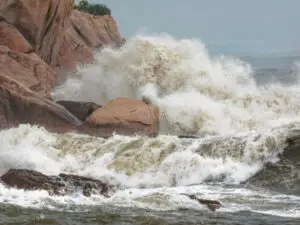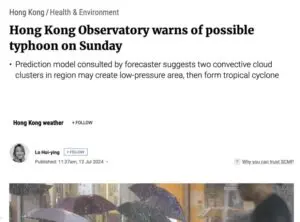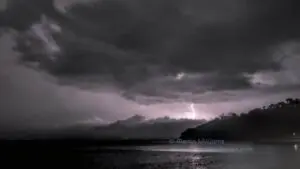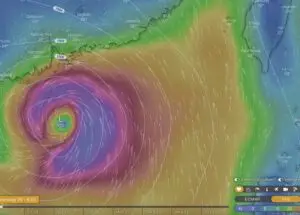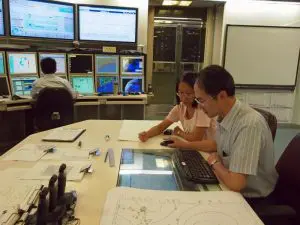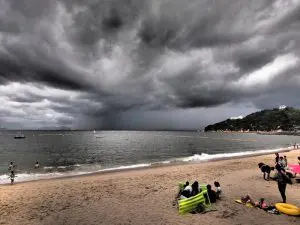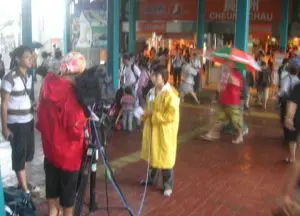Hong Kong’s Number 8 tropical cyclone warning can be controversial.
Hong Kong’s Number 8 tropical cyclone warning can be controversial; the signal means that gale force winds are expected or blowing in Victoria Harbour.
Especially as this may mean hurricane force winds may soon follow – as the eye of a typhoon approaches – this signal can prompt a virtual shutdown of Hong Kong.
But, hurricane force winds rarely follow; and there have been occasions when the Number 8 has been issued, then little happened bar strong winds and rain – and business folk have complained about the city shutdown causing economic losses they believe are unnecessary.
Hearing a discussion about Hong Kong’s tropical cyclone warning signals on RTHK Radio 3 recently, I emailed to suggest that there might be two signals when gales are due: a Number 8 if stronger winds don’t seem imminent, and another signal if there appears to be a chance that the winds will reach and then surpass gale force. Dr Wong of the Hong Kong Observatory, who was on air at the time, thanked me for my suggestion but said we already have the second signal – the Number 9. But, the Number 9 is issued only when gales are blowing and increasing, not before gales have started; I emailed the Observatory to say so, and this led to the following correspondence.
While my first email to the Hong Kong Observatory, and a couple that followed, aren’t too informative (you’ll find them if you scroll down), the last email – a thorough response from acting director K.H. Yeung – may interest you if you too wonder if the current tropical cyclone / typhoon warning system is inadequate; also mentions apparent great accuracy in forecasting thunderstorm timings.
(As I post this, Hurricane Charley is still battering Florida – it’s proved a “good” example of a storm that didn’t behave as forecast: Hurricane Intensified Unexpectedly Near Florida reports the New York Times [registration required], saying it was anticipated to strike as a Category 2 storm, with 100 miles per hour winds, but within 100 miles of the coast it began intensifying, hitting the coast as a powerful, Category 4 storm with sustained winds of 145 miles per hour. New Scientist soon followed, with Hurricane Charley’s sharp turn baffles scientists – this mentioned that though intense, Charley was relatively small in diameter.)
From K.H. Yeung, acting director of the Hong Kong Observatory, 4 August 2004:
Thank you for sharing your observations and views with us again.
No. 10 is a relatively rare occurrence, issued only 13 times since 1946. Rare events are typically difficult to forecast especially if we try to make a prediction early. Statistically, every time a No.8 is hoisted, there is only a 14% chance that it would evolve into a No. 10. If we take advantage of this fact and always predict a No. 10 would not be likely when we issue a No. 8, we would be right on 86% of occasions, which is a high figure in weather forecasting.
However, I am not sure if we could score as high or higher if we try to make a prediction well in advance each time by working on the forecast track, intensity, size and structure of the tropical cyclone. Even if we are wrong once every 10 times we predict a No. 10 is not likely, the fact that we have been right so many times before would make it particular dangerous for the public who gets caught in hurricane force winds unexpectedly.
That is why we do not make it a routine to indicate possible further signal changes when we issue a No. 8, but only do so occasionally when the meteorological condition is straight forward. I have to add that close approach of a tropical storm (rather than a typhoon) is not necessary straight forward. We have seen storms intensifying close to Hong Kong, such as Sam in 1999 which intensified into a typhoon within 50 km of Hong Kong.
[Edited by Martin: as I post this, Hurricane Charley is still battering Florida – it’s proved a “good” example of a storm that didn’t behave as forecast: Hurricane Intensified Unexpectedly Near Florida reports the New York Times {registration required}, saying it was anticipated to strike as a Category 2 storm, with 100 miles per hour winds, but within 100 miles of the coast it began intensifying, hitting the coast as a powerful, Category 4 storm with sustained winds of 145 miles per hour.]
I don’t think we can take gale force winds too lightly in Hong Kong. On most occasions when No. 8 was issued, some injuries and damages were reported somewhere in the territory, with people hurt by falling or flying objects such as signboards, scaffoldings or broken branches. Occasionally, lives near the shore or at sea were claimed by waves or swell. More people
will get hurt, and more property would be damaged, if they do not take proper precaution against the occurrence of gale force winds.
The existing tropical cyclone warning signal serves primarily as a trigger for action and further information on the tropical cyclone and its impact to Hong Kong are given in advisory bulletins that go with the signal. Different sectors of the community can take into account of the information, the nature of their own business and activities as well as their own level of acceptable risk in making their own response decisions. The current system has sufficient flexibility to allow actions to be taken in line with the specific needs of different sectors of the community.
Turning to thunderstorm warnings, a warning is issued whenever necessary and can therefore be issued at any odd minute. The validity period of the warning however is usually whole hours, and as such the warning could end on an odd minute as well.
Besides inclusion in warning bulletins, the thunderstorm warning is transformed automatically by the computer to “The thunderstorm warning has been issued and it will remain effective until XX:XX a.m./p.m.” for inclusion in the hourly bulletin accessible from the “current weather” section on the HKO website and the Dial-a-Weather recording. That may sound over-precise but it has to be so for consistency with the duration of validity of the warning. We are aware of the problem and our forecasters have been asked to try to issue thunderstorm warnings on multiples of 5 minutes past the hour, but this cannot always be done when the threat of lightning is imminent.
Thank you again for your observations and views.
Best regards,
KH
—–Original Message—–
From: Martin Williams
Sent: Wednesday, 28 July, 2004 11:14
To: khyeung.hko
Subject: Re: typhoon signals
Hi KH:
Hmm, well, if you would aim for 100% accuracy in forecast when hoisting
8a or 8b (or 8 or 9), would be unique – as none of your other forecasts
are 100% accurate! (Especially those for 7 days ahead.)
But, not being fully accurate doesn’t make a forecast worthless.
It seems to me a big problem now is that No 8 is taken as automatic
trigger for action – offices closing and so on. And this hardly seems
necessary if only get gales. (I’m from east coast of England; gales by
no means infrequent, storm force winds rarely.)
Even adding “No 8 is in force, but we believe winds won’t strengthen
further” won’t change this.
If have No 8, or No 9 (say; but different 9 – for gales with chance of
increase anticipated, not actually gales blowing and increasing), would
go long way towards eliminating this.
And, yes, it’s not 100% accurate – but again, public must be used to
that from the Observatory. It’s best forecast based on actual
conditions, and past situations, experience.
With last week’s, would have put up No 8. So too with a storm I
remember some years ago – 8 went up in the morning, a friend phoned to
ask what might happen, and I said no worry, the storm centre was south
of us and heading west, so no problem.
In second case, would also be 8. But, if change of direction towards
HK, change to 9. (I know storms can change direction pretty fast, but
these days, forecasts are reasonable, especially once a storm is
properly moving.)
With typhoon approaching, looking as if centre will be close, would
hoist 9 (perhaps 8 first if there’s some time, storm not real fast;
perhaps direct to 9).
This way, gales alone wouldn’t shut Hong Kong. (And, maybe Hong Kong
will be safer as and when a full typhoon really hits – won’t be so much
crying “Wolf!” so people may pay these storms more respect, take full
precautions.)
The observatory’s funny at times.
Maybe get a thunderstorm warning till 4.27pm and 11.4456 seconds (well,
not quite so precise, but within minutes).
Then, get an observatory guy interviewed on media about a storm that’s
100km away, heading towards us at 20km/hr, and is asked how long before
it’s nearest to us, and he says he has no idea – when I want to scream
“five hours, if it maintains current course and speed! Five hours –
it’s obvious!!” (and, mostly, such rough calculations work pretty
well).
Best regards,
Martin
On 27 Jul, 2004, at 16:22, khyeung.hko wrote:
Dear Mr. Williams,
Mr. C.Y. Lam is on leave. I will bring your email to his attention
when he returns. Meanwhile I would like to thank you for your
suggestions on the tropical cyclone warning signal system.
The present tropical cyclone warning signal system is a graded one
based on forecast wind conditions in Hong Kong to alert the public of
the threat of high winds associated with a tropical cyclone.
Your suggestion of having two kinds of number 8 and the rationale
behind it require that we forecast and tell the public (through
choosing one of the two number 8 signals) how the local wind strength
will change a number of hours after the issuance of the number 8.
Unfortunately, the state of the technology does not permit us to
forecast the local wind conditions so far ahead with consistent
accuracy. So the intended benefit of your suggested change to the
signal system will be negated by occasional inaccurate prediction of
what may or may not happen after the issuance of the number 8. Having
said that, there are occasions when we do have confidence in whether
higher signal are likely or unlikely. In these occasions, we give the
information to the public in the advisory bulletins that go with the
signal. That way, we can maintain public confidence in our tropical
cyclone warning service which is crucial to the public’s correct
response to signals.
Thank you again for your interest in this important aspect of our work.
Yours sincerely,
K. H. Yeung
Acting Director of the Hong Kong Observatory
From: Martin Williams
Sent: Friday, 23 July, 2004 9:37
To: C.Y.LAM
Subject: typhoon signals
Hi CY:
Just heard Dr Wong on RTHK radio 3, in discussion about typhoon
signals.
I emailed:
“Does seem to me unnecessary to shut down Hong Kong when have warning
of gales – especially if winds almost certain not to get stronger than
that.
Very different if a number 10 looks possible; number 10 winds surely
merit closure.
Maybe could have two kinds of number 8. One with number 10 signal
looking likely within next few hours. The other with number 10 looking
unlikely.
– with former should have put latter], up to businesses how to
respond; with latter [former], should be wider shut-downs.”
Dr Wong thanked me for suggestion, said already have number 9 that
serves this purpose.
Dr Wong is not correct.
For number 9 to serve this purpose, would hoist either 8 or 9 as a
storm approaches – not 8 first, and maybe 9 later, as evidently
currently happens. (In current system, seems it’s maybe too late for
offices to shut by time the 9 is up, so no 8 is trigger.)
Right now, 8 is uninformative beyond whether gales are imminent, yet
there is far more info available. Time for a better system? (Including
something re how powerful a typhoon is – akin to US hurricane system;
decision makers could surely figure the meaning.)
Hope you can forward this to Dr Wong.
Regards,
Martin
Weather including tropical cyclones
Rare November Tropical Cyclones Including Typhoons in Hong Kong
As I write on 13 November 2024, Tropical Cyclone Toraji is set to pass over Hong…
Typhoons and Rainstorms Past Help Hong Kong Forecasts Today
Wetter, Wilder Weather Events Loom with Warming World You may find yourself on a Hong Kong…
“Typhoon to Hong Kong Soon” Makes Great Clickbait
While Hong Kong is sometimes hit by typhoons, predicting them in advance is tricky. Yet this…
Lightning-packed Supercell over Cheung Chau, Hong Kong
Yesterday evening (30 April 2024), weather monitoring imagery showed an intense rainstorm/thunderstorm area – a “supercell”…
Tropical Cyclone Ma-on Headed for Hong Kong
25 August 2022 (evening) update: Ma-on took a track somewhat south and west of earlier forecasts;…
Severe Typhoon Mangkhut highlights perils of massive reclamation by Lantau
Typhoon Mangkhut helped show “storm surge” is a threat to modern cities, not just something for…
Typhoon Jebi a Warning for East Lantau Metropolis aka Lantau Tomorrow Vision
To anyone concerned about plans for Lantau Tomorrow Vision, the clobbering of Kansai by T Jebi…
Mad Lantau Metropolis Plans Should be Scuppered by Storm Surge Threat
A consideration of science suggests the reclamation plans, including for East Lantau Metropolis are foolhardy, even…
As Hong Kong Sizzles the World Keeps Warming
While climate change may have long seemed an issue for hardcore, tree-hugging environmentalists, concerns are spreading.
Typhoon Haiyan Lessons for Hong Kong
Typhoon Haiyan was among the strongest storms on record, and devastated a swathe of the Philippines.…
Forecasters Benefit from Flights into Typhoons
As well as computer models and weather station info, the Hong Kong Observatory is uses flights…
Hong Kong weather outlook warmer wetter wilder
With global warming only just getting started, according to scientists, it’s time for Hong Kong to…
Typhoon Vicente hurricane force winds blast Hong Kong
Severe Typhoon Vicente slammed Hong Kong on 23 and 24 July 2012, with hurricane force winds…
Severe Tropical Storm Pabuk
Severe Tropical Storm Pabuk looked set to have passed Hong Kong, barely causing an impact other…
Hong Kong Typhoons including Calamitous Storm Surges
Typhoons have sometimes caused massive damage and loss of life in Hong Kong. Just months after…
Hong Kong tropical cyclones
Hong Kong can be impacted by tropical cyclones including and typhoons. Happily, typhoons are scarce near…


